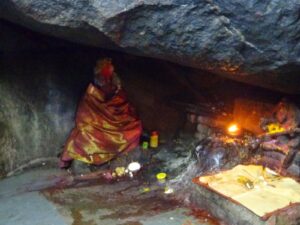
Basar village in Adilabad district, Telangana is situated on the banks of river Godavari. Vyasa Muni Guha is a cave on top of a hill next to the Jnana Saraswathi Temple in Basara.
According to a popular legend great sage Vyasa along with his son sage Shuka and other disciples desponded and dejected by the Kruskethra War left on a pilgrimage towards Dakshinapatnam (southern India). He retired on the banks of River Godavari for a penance. This was later called Vasar in his honour and which gradually came to be known as Basar.
During his stay, Sage Vyasa bought three handfuls of sand and made them into three heaps daily after the morning bath. It is believed that the heaps transformed into the divine trio The Lakshmi, The Sarada and The Gowri. The idol made of sand is smeared with turmeric.
Another popular legend from Brahmanda Purana says that Sage Valmiki prior writing his magnus opus The Ramayan; installed Goddess Saraswathi and seeked her blessing. One can find the marble samadi of Valmiki near the Saraswathi temple.
This cave has a narrow entrance and one has to wriggle through it to enter the small enclosure.
Source:
http://hill-temples.blogspot.in/2010/11/vyasa-muni-guha-jnana-saraswathi-temple.html
http://mokatha.blogspot.in/2015/02/writers-of-mahabharata.html


